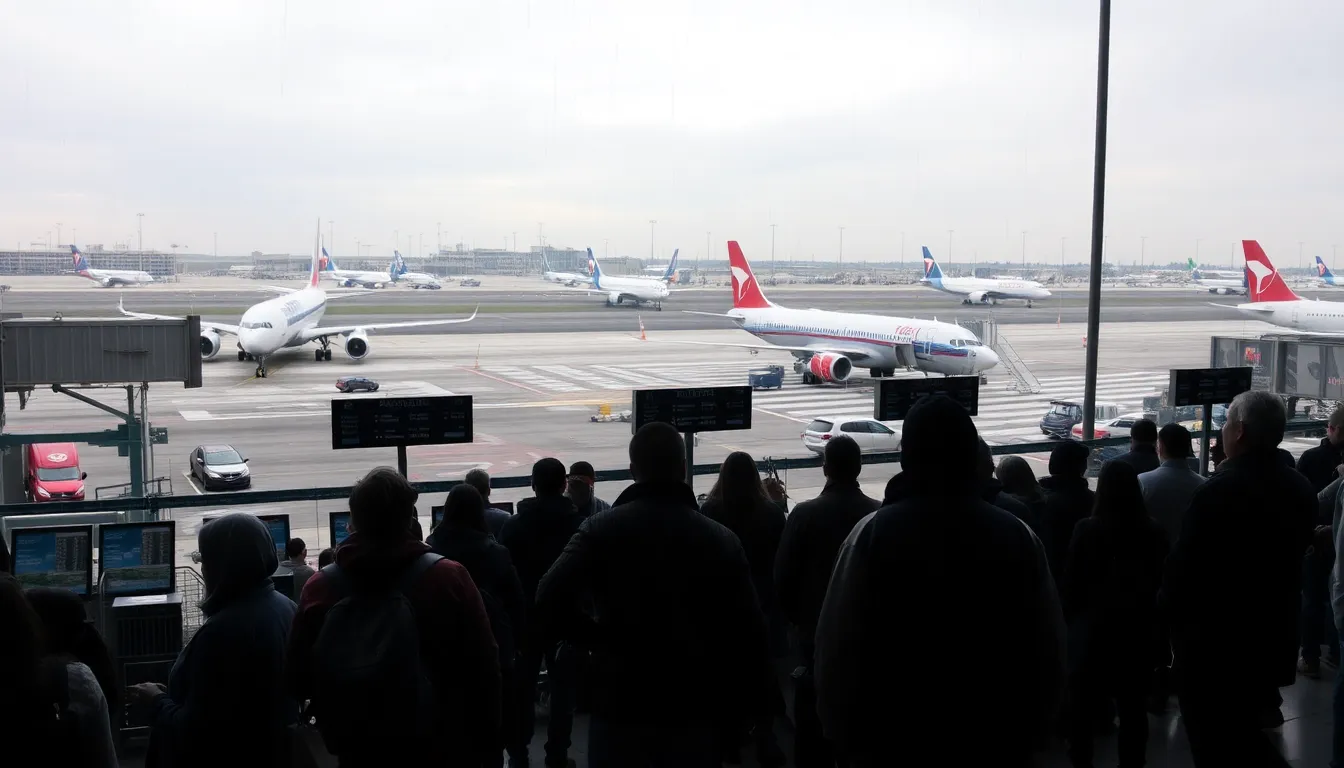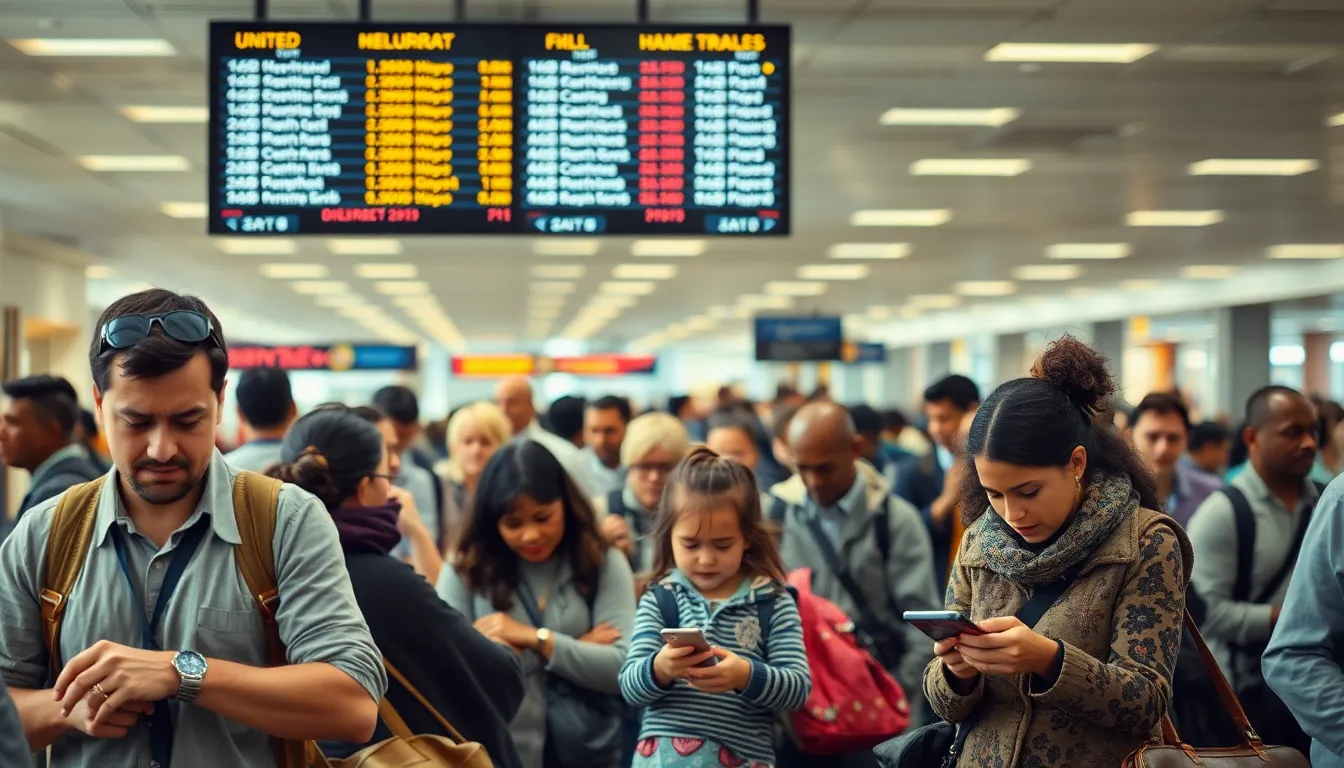Table of Contents
ToggleTraveling can feel like a game of chance, but when it comes to United Airlines at Newark Airport, the odds might just be stacked against you. Picture this: you’re all packed and ready to jet off to your dream destination, only to find yourself in a waiting game that rivals a suspense thriller. Delays at Newark have become a rite of passage for many travelers, testing patience and sanity in equal measure.
But don’t worry; you’re not alone in this adventure. With a little humor and a dash of insight, navigating these delays can turn from a headache into a memorable travel story. Buckle up as we dive into the world of United Airlines Newark Airport delays, where every minute counts and every traveler has a tale to tell.
Overview Of United Airlines Newark Airport Delays
Travelers frequently encounter delays flying with United Airlines at Newark Airport. Statistics indicate that approximately 30% of flights experience delays, often due to weather, air traffic control, or operational issues. Passengers express frustration over unexpected wait times, impacting both schedules and itineraries.
Air traffic congestion plays a significant role in these delays. Newark Airport ranks as one of the busiest airports in the United States, handling over 46 million passengers annually. Increased flight volume during peak travel seasons amplifies this issue.
Flight cancellations also occur alongside delays. A rise in cancellations complicates travel plans for passengers, forcing them to adjust and reschedule connections. Customer service representatives assist, but the wait for a solution can add to the stress.
United Airlines is aware of these challenges. They often communicate proactive measures, such as rebooking options and compensation for affected travelers. Notifications via email and text alerts keep passengers informed about potential delays or cancellations.
Passengers benefit from utilizing real-time tracking tools. Many apps provide up-to-date information on flight statuses and expected delays. By staying informed, travelers can make better decisions and minimize inconvenience caused by unexpected changes.
Frequent fliers and occasional travelers alike may benefit from understanding these patterns. Knowledge of peak travel times can help select flights with lower chances of delays. United Airlines strives to improve the passenger experience despite these ongoing challenges at Newark Airport.
Causes Of Delays

Flight delays at Newark Airport often stem from various interconnected issues that affect United Airlines. Understanding these causes helps travelers navigate their journeys more effectively.
Weather Conditions
Inclement weather leads to significant delays. Snowstorms, heavy rain, and fog create hazardous conditions, forcing aircraft to remain on the ground longer than planned. This situation results in cascading effects on the entire schedule. In fact, weather-related delays contribute to 70% of all flight disruptions at Newark Airport. Rain impacts visibility, while snow requires extensive de-icing procedures, further prolonging wait times.
Operational Challenges
Operational challenges significantly impact United Airlines flights. Equipment failures and crew shortages disrupt schedules frequently. Newark Airport handles around 1,300 flights daily, creating a high volume of operations that complicates management. Air traffic congestion ranks as a primary operational hurdle, leading to delays in departures and arrivals. Moreover, late incoming flights directly affect subsequent departures, intensifying the ripple effect throughout the day.
Impact On Passengers
Delays at Newark Airport significantly affect passengers flying with United Airlines. Those encountering delays face interruptions that can disrupt travel plans.
Travel Disruptions
Travel disruptions have become an expected part of flying with United Airlines. Approximately 30% of flights experience delays, commonly caused by factors like inclement weather, air traffic control, or operational issues. Instances of snowstorms, heavy rain, and fog account for 70% of these delays. Equipment failures and crew shortages contribute to extended wait times, complicating travel for many. Furthermore, when incoming flights are late, a chain reaction occurs, resulting in additional delays throughout the day. Passengers experience longer waits, missed connections, and heightened stress during these periods.
Customer Complaints
Customer complaints often center around lengthy delays and cancellations. Frustrated travelers share experiences of uncertainty and inadequate communication. Many express dissatisfaction with not receiving timely updates regarding flight statuses. A proactive approach from United Airlines attempts to address these concerns by offering rebooking options and compensation. Still, passengers appreciate clearer notifications and resolution processes. It’s not uncommon for travelers to voice their frustrations online, leading to negative reviews and social media feedback. As these challenges persist, such complaints will likely continue to shape the passenger experience at Newark Airport.
Solutions And Mitigations
Addressing Newark Airport delays requires strategic solutions aimed at improving the travel experience for United Airlines passengers. Two key areas to focus on include communication and staffing.
Improved Communication
Effective communication can significantly enhance passenger experiences. Providing timely updates is crucial during delays, as 30% of flights encounter postponements. Utilizing SMS and mobile app notifications ensures travelers remain informed. Furthermore, increasing the availability of customer service agents fosters real-time assistance. Enhanced online resources also play a role by enabling passengers to track their flights and receive alerts. With clearer messaging, organizations can streamline operations and reduce frustration among passengers.
Increased Staffing
Increasing staffing levels can alleviate operational challenges at Newark Airport. A shortage of crew members contributes to delays, especially during peak travel times. When additional personnel are available, they can manage the workflow more efficiently during disruptions. Hiring more customer service representatives provides timely assistance, helping minimize stress during delays. Operational efficiency improves significantly as a result, which impacts the overall flight experience for travelers. Prioritizing staff well-being is also essential in addressing crew shortages and maintaining a reliable schedule.
Future Outlook
Recent trends indicate a potential shift in how United Airlines addresses delays at Newark Airport. These adjustments aim to enhance the travel experience for passengers.
Changes In Policy
Updated policies focus on prioritizing communication and customer care. Enhanced procedures will provide proactive notifications about flight statuses. Such protocols ensure passengers receive timely information during unexpected disruptions. Additionally, clearer rebooking guidelines will simplify alternative travel arrangements. Investments in customer service training also promise to improve interactions during stressful situations. Overall, these changes reflect a commitment to addressing passenger concerns and minimizing frustration.
Technology Enhancements
Technological advances play a crucial role in mitigating delays at Newark Airport. Implementing real-time tracking systems will allow travelers to access up-to-date flight information conveniently. Integrated mobile app features will send alerts directly to smartphones, improving communication. Upgrading airport infrastructure will support better air traffic management. Automation of specific processes may reduce wait times, enhancing operational efficiency. These technology-driven enhancements prioritize passenger convenience and aim to streamline overall flight operations.
Travelers flying with United Airlines at Newark Airport face a unique set of challenges due to frequent delays. While the airline is taking steps to improve communication and operational efficiency, the current state of delays continues to impact passenger experiences. Enhanced customer service and technological advancements may offer relief in the future. For now, passengers should remain adaptable and informed, keeping an eye on updates and utilizing available resources. Embracing a positive outlook can transform these frustrating moments into memorable travel stories.




